Effects of Salinity and Eutrophication Variations on the Growth of Myriophyllum spicatum
Abstract
1. Introduction
2. Results
2.1. Water Quality and Response of Plant Growth Traits
2.2. Response of Plant Physiological Traits
2.3. Relationship Among Plant Traits
3. Discussion
4. Materials and Methods
4.1. Experiment Design
4.2. Parameter Measurements
4.3. Statistical Analyses
5. Conclusions
Author Contributions
Funding
Data Availability Statement
Conflicts of Interest
Appendix A
| PC1 | PC2 | PC3 | |
|---|---|---|---|
| Stem N | −0.24 | 0.10 | −0.10 |
| Root–shoot Biomass Ratio | 0.24 | −0.14 | −0.12 |
| SS | −0.18 | −0.29 | 0.30 |
| Leaf N | 0.14 | 0.29 | 0.20 |
| Stem P | 0.14 | 0.35 | 0.15 |
| Root Biomass | 0.27 | −0.24 | −0.14 |
| FAA | 0.15 | 0.21 | −0.29 |
| MDA | −0.22 | −0.19 | 0.40 |
| Leaf N:P | −0.23 | −0.23 | −0.30 |
| Total Biomass | 0.30 | −0.28 | −0.04 |
| Leaf Biomass | 0.27 | −0.31 | 0.05 |
| SOD | −0.20 | −0.21 | 0.13 |
| Shoot Biomass | 0.29 | −0.27 | 0.06 |
| GS | −0.11 | −0.08 | 0.56 |
| Leaf P | 0.24 | 0.28 | 0.27 |
| Stem N:P | −0.26 | −0.27 | −0.18 |
| Stem Biomass | 0.31 | −0.15 | 0.05 |
| Stem Length | 0.31 | −0.14 | 0.17 |
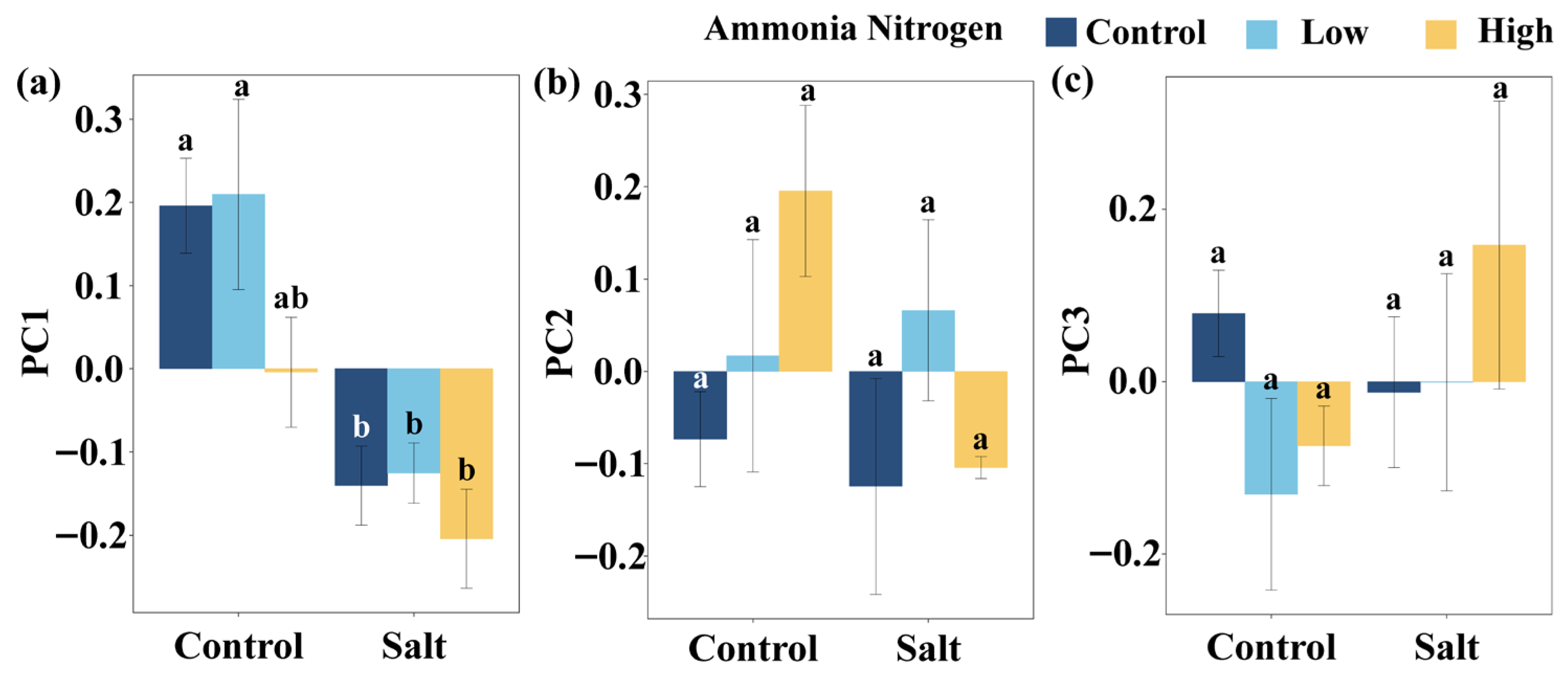
References
- Dale, P.E.R.; Connelly, R. Wetlands and Human Health: An Overview. Wetl. Ecol. Manag. 2012, 20, 165–171. [Google Scholar] [CrossRef]
- Zhou, Q. Long-Term Changes of Nitrogen and Phosphorus Loadings to a Large Lake in North-West Ireland. Water Res. 2000, 34, 922–926. [Google Scholar] [CrossRef]
- Ayele, H.S.; Atlabachew, M. Review of Characterization, Factors, Impacts, and Solutions of Lake Eutrophication: Lesson for Lake Tana, Ethiopia. Environ. Sci. Pollut. Res. 2021, 28, 14233–14252. [Google Scholar] [CrossRef] [PubMed]
- Bhagowati, B.; Ahamad, K.U. A Review on Lake Eutrophication Dynamics and Recent Developments in Lake Modeling. Ecohydrol. Hydrobiol. 2019, 19, 155–166. [Google Scholar] [CrossRef]
- Panthi, J.; Pradhanang, S.M.; Nolte, A.; Boving, T.B. Saltwater Intrusion into Coastal Aquifers in the Contiguous United States—A Systematic Review of Investigation Approaches and Monitoring Networks. Sci. Total Environ. 2022, 836, 155641. [Google Scholar] [CrossRef]
- Tursi, A.; Lisco, A.; Chimienti, G.; Mastrototaro, F.; Ungaro, N.; Bottalico, A. Salinity as a Key Factor in Structuring Macrophyte Assemblages in Transitional Water Bodies: The Case of the Apulian Coastal Lagoons (Southern Italy). Diversity 2023, 15, 615. [Google Scholar] [CrossRef]
- Liu, L.; Du, N.; Eller, F.; Ye, S.; Li, X.; Wei, J.; Guo, Y.; Brix, H.; Guo, W. Ecological Mechanisms of Carbon Sequestration in Vegetated Coastal Wetland Ecosystem: Exploring the Roles of Biodiversity and Environmental Changes. JMEE 2025, 12, 35–47. [Google Scholar] [CrossRef]
- Guo, X.; Song, H.; Wu, P.; Liu, L.; Li, M.; Xie, L.; Jespersen, E.; Ye, S.; Guo, W. Intraspecific Elementome Variation of the Clonal Grass Phragmites australis Reflects Environmental Variation More than Genetic and Epigenetic Variation. J. Plant Ecol. 2025, 18, rtaf070. [Google Scholar] [CrossRef]
- Liu, L.; Codogno, B.; Wei, W.; Zhang, X.; Gao, J.; Dokuchaeva, V.; Ma, L.; Wu, P.; Yu, Q.; Guo, W. Investigating the Potential Effects of Microplastics on the Growth and Functional Traits in Two Aquatic Macrophytes (Myriophyllum spicatum and Phragmites australis) in Mesocosm Experiments. Water 2024, 17, 14. [Google Scholar] [CrossRef]
- Flowers, T.J.; Munns, R.; Colmer, T.D. Sodium Chloride Toxicity and the Cellular Basis of Salt Tolerance in Halophytes. Ann. Bot. 2015, 115, 419–431. [Google Scholar] [CrossRef]
- Shi, H.; Shi, Q.; Zhou, X.; Cui, C.; Li, X.; Zhang, Z.; Zhu, C. Influence of Surface Water and Groundwater on Functional Traits and Trade-off Strategies of Oasis Communities at the End of the Keriya River, China. Front. Plant Sci. 2024, 15, 1340137. [Google Scholar] [CrossRef]
- Ahmad, S.; Ahmad, R.; Ashraf, M.Y.; Ashraf, M.; Waraich, E.A. Sunflower (Helianthus annuus L.) Response to Drought Stress at Germination and Seedling Growth Stages. Pak. J. Bot. 2009, 41, 647–654. [Google Scholar]
- Yu, Q.; Wang, H.-Z.; Li, Y.; Shao, J.-C.; Liang, X.-M.; Jeppesen, E.; Wang, H.-J. Effects of High Nitrogen Concentrations on the Growth of Submersed Macrophytes at Moderate Phosphorus Concentrations. Water Res. 2015, 83, 385–395. [Google Scholar] [CrossRef]
- Yu, Q.; Wang, H.; Liu, M.; Xu, C.; Ma, Y.; Guo, W.; Jeppesen, E. Interactive Effects of Benthivorous Fish Disturbance and Ammonium Loading on Two Submersed Macrophytes of Contrasting Growth Forms Based on a Mesocosm Study. Front. Environ. Sci. 2022, 10, 1024524. [Google Scholar] [CrossRef]
- Song, H.; Jespersen, E.; Guo, X.; Du, N.; Xie, L.; Pei, L.; Ye, S.; Wang, R.; Brix, H.; Eller, F.; et al. Differences in Relative Air Humidity Affect Responses to Soil Salinity in Freshwater and Salt Marsh Populations of the Dominant Grass Species Phragmites australis. Hydrobiologia 2021, 848, 3353–3369. [Google Scholar] [CrossRef]
- Szklarek, S.; Górecka, A.; Wojtal-Frankiewicz, A. The Effects of Road Salt on Freshwater Ecosystems and Solutions for Mitigating Chloride Pollution—A Review. Sci. Total Environ. 2022, 805, 150289. [Google Scholar] [CrossRef] [PubMed]
- Zhao, H.; Zuo, Z.; Yang, L.; Zhang, L.; Lv, T.; Yu, D.; Wang, Z. Similarities and Differences in the Physiological Adaptation to Water Salinity between Two Life Forms of Aquatic Plants in Alpine and Arid Wetlands. Sci. Total Environ. 2024, 908, 168449. [Google Scholar] [CrossRef]
- Zhou, Q.; Shi, M.; Zhu, Z.; Cheng, L. Ecophysiological Responses of Carpinus turczaninowii L. to Various Salinity Treatments. Forests 2019, 10, 96. [Google Scholar] [CrossRef]
- Zhang, G.; Cai, Y.; Luo, H.; Hong, S.; Song, C.; Yan, J.; Fang, H. Effects of Abiotic Factors on Plant Community Composition and Functional Traits in the Liaohe Estuary. JMEE 2024, 11, 114–156. [Google Scholar] [CrossRef]
- Park, S.-H.; Kwon, N.; Lee, J.-H.; Yoon, J.; Shin, I. Synthetic Ratiometric Fluorescent Probes for Detection of Ions. Chem. Soc. Rev. 2020, 49, 143–179. [Google Scholar] [CrossRef]
- Yu, Q.; Wang, H.; Wang, H.; Xu, C.; Liu, M.; Ma, Y.; Li, Y.; Ma, S.; Hamilton, D.P.; Jeppesen, E. Effects of High Ammonium Loading on Two Submersed Macrophytes of Different Growth Form Based on an 18-Month Pond Experiment. Front. Plant Sci. 2022, 13, 939589. [Google Scholar] [CrossRef]
- Xia, W.; Zhu, B.; Qu, X.; Liu, H.; Liu, Y.; Chen, X.; Rudstam, L.G.; Ni, L.; Chen, Y. Effects of Salinity on Sprouting and Growth of Three Submerged Macrophytes. Ecohydrology 2020, 13, e2235. [Google Scholar] [CrossRef]
- Chen, T.; Jiang, H.S.; Wang, Y.; Wang, S.; Yin, L.; Cao, Y. Responses of Five Submerged Macrophytes to NaCl Salinity in a Tropical Mesocosm Study. Fundam. Appl. Limnol. 2020, 193, 359–370. [Google Scholar] [CrossRef]
- Bornette, G.; Puijalon, S. Response of Aquatic Plants to Abiotic Factors: A Review. Aquat. Sci. 2011, 73, 1–14. [Google Scholar] [CrossRef]
- Zhang, C.; Chen, X.; Wang, J.; Tan, L. Toxic Effects of Microplastic on Marine Microalgae Skeletonema costatum: Interactions between Microplastic and Algae. Environ. Pollut. 2017, 220, 1282–1288. [Google Scholar] [CrossRef] [PubMed]
- Ayi, Q.; Zeng, B.; Yang, K.; Lin, F.; Zhang, X.; Van Bodegom, P.M.; Cornelissen, J.H.C. Similar Growth Performance but Contrasting Biomass Allocation of Root-Flooded Terrestrial Plant Alternanthera philoxeroides (Mart.) Griseb. in Response to Nutrient Versus Dissolved Oxygen Stress. Front. Plant Sci. 2019, 10, 111. [Google Scholar] [CrossRef] [PubMed]
- Cao, T.; Xie, P.; Ni, L.; Zhang, M.; Xu, J. Carbon and Nitrogen Metabolism of an Eutrophication Tolerative Macrophyte, Potamogeton crispus, under NH4+ Stress and Low Light Availability. Environ. Exp. Bot. 2009, 66, 74–78. [Google Scholar] [CrossRef]
- Zhang, M.; Cao, T.; Ni, L.; Xie, P.; Li, Z. Carbon, Nitrogen and Antioxidant Enzyme Responses of Potamogeton crispus to Both Low Light and High Nutrient Stresses. Environ. Exp. Bot. 2010, 68, 44–50. [Google Scholar] [CrossRef]
- Cao, T.; Ni, L.; Xie, P.; Xu, J.; Zhang, M. Effects of Moderate Ammonium Enrichment on Three Submersed Macrophytes under Contrasting Light Availability: Effects of Ammonium on Macrophytes. Freshw. Biol. 2011, 56, 1620–1629. [Google Scholar] [CrossRef]
- Gao, J.; Ren, P.; Zhou, Q.; Zhang, J. Comparative Studies of the Response of Sensitive and Tolerant Submerged Macrophytes to High Ammonium Concentration Stress. Aquat. Toxicol. 2019, 211, 57–65. [Google Scholar] [CrossRef]
- Hillmann, E.R.; La Peyre, M.K. Effects of Salinity and Light on Growth and Interspecific Interactions between Myriophyllum spicatum L. and Ruppia maritima L. Aquat. Bot. 2019, 155, 25–31. [Google Scholar] [CrossRef]
- Sheng, W.; Liu, L.; Wu, Y.; Yin, M.; Yu, Q.; Guo, X.; Song, H.; Guo, W. Exploring Salt Tolerance and Indicator Traits across Four Temperate Lineages of the Common Wetland Plant, Phragmites australis. Sci. Total Environ. 2024, 912, 169100. [Google Scholar] [CrossRef] [PubMed]
- Munns, R.; Tester, M. Mechanisms of Salinity Tolerance. Annu. Rev. Plant Biol. 2008, 59, 651–681. [Google Scholar] [CrossRef] [PubMed]
- Velthuis, M.; Teurlincx, S.; Van Dijk, G.; Smolders, A.J.P.; De SenerpontDomis, L.N. Salinisation Effects on Freshwater Macrophyte Growth and Establishment in Coastal Eutrophic Agricultural Ditches. Freshw. Biol. 2023, 68, 547–560. [Google Scholar] [CrossRef]
- Santini, R.; Vantini Checchio, M.; Correia Nunes, L.S.; Lupino Gratão, P.; Monteiro Camargo, A.F. Do Salinity, Total Nitrogen and Phosphorus Variation Induce Oxidative Stress in Emergent Macrophytes along a Tropical Estuary? Aquat. Ecol. 2024, 58, 399–409. [Google Scholar] [CrossRef]
- Kang, C.X.; Li, J.; Liu, Y.; Tong, Z. Effects of High Nitrogen Concentration and Low Water Level on the Growth of the Submerged Macrophyte Vallisneria spinulosa. J. Freshw. Ecol. 2022, 37, 161–172. [Google Scholar] [CrossRef]
- Tan, L.; Zhu, Z.; Yu, Y.; Suo, S.; Zhao, M.; Liang, W. Characteristics of Nitrogen and Polycyclic Aromatic Hydrocarbon Pollution and Their Coupled Remediation Mechanisms in Reclaimed Water Wetlands. Res. Environ. Sci. 2024, 37, 2710–2721. [Google Scholar] [CrossRef]
- Song, H.; Guo, X.; Yang, J.; Liu, L.; Li, M.; Wang, J.; Guo, W. Phenotypic Plasticity Variations in Phragmites australis under Different Plant–Plant Interactions Influenced by Salinity. J. Plant Ecol. 2024, 17, rtae035. [Google Scholar] [CrossRef]
- Yu, M.; Li, Y.; Zhang, K.; Yu, J.; Guo, X.; Guan, B.; Yang, J.; Zhou, D.; Wang, X.; Li, X.; et al. Studies on the dynamic boundary of the fresh-salt water interaction zone of estuary wetland in the Yellow River Delta. Ecol. Eng. 2023, 188, 106893. [Google Scholar] [CrossRef]
- Zhang, Y.; Cheng, W.; Di, H.; Yang, S.; Tian, Y.; Tong, Y.; Huang, H.; Escalona, V.H.; Tang, Y.; Li, H.; et al. Variation in Nutritional Components and Antioxidant Capacity of Different Cultivars and Organs of Basella Alba. Plants 2024, 13, 892. [Google Scholar] [CrossRef]
- ISO 10390: 2021; Soil, Treated Biowaste and Sludge-Determination of pH. International Organization for Standardization: Geneva, Switzerland, 2021.
- ISO 11265: 1994; Soil Quality—Determination of the Specific Electrical Conductivity. International Organization for Standardization: Geneva, Switzerland, 1994.
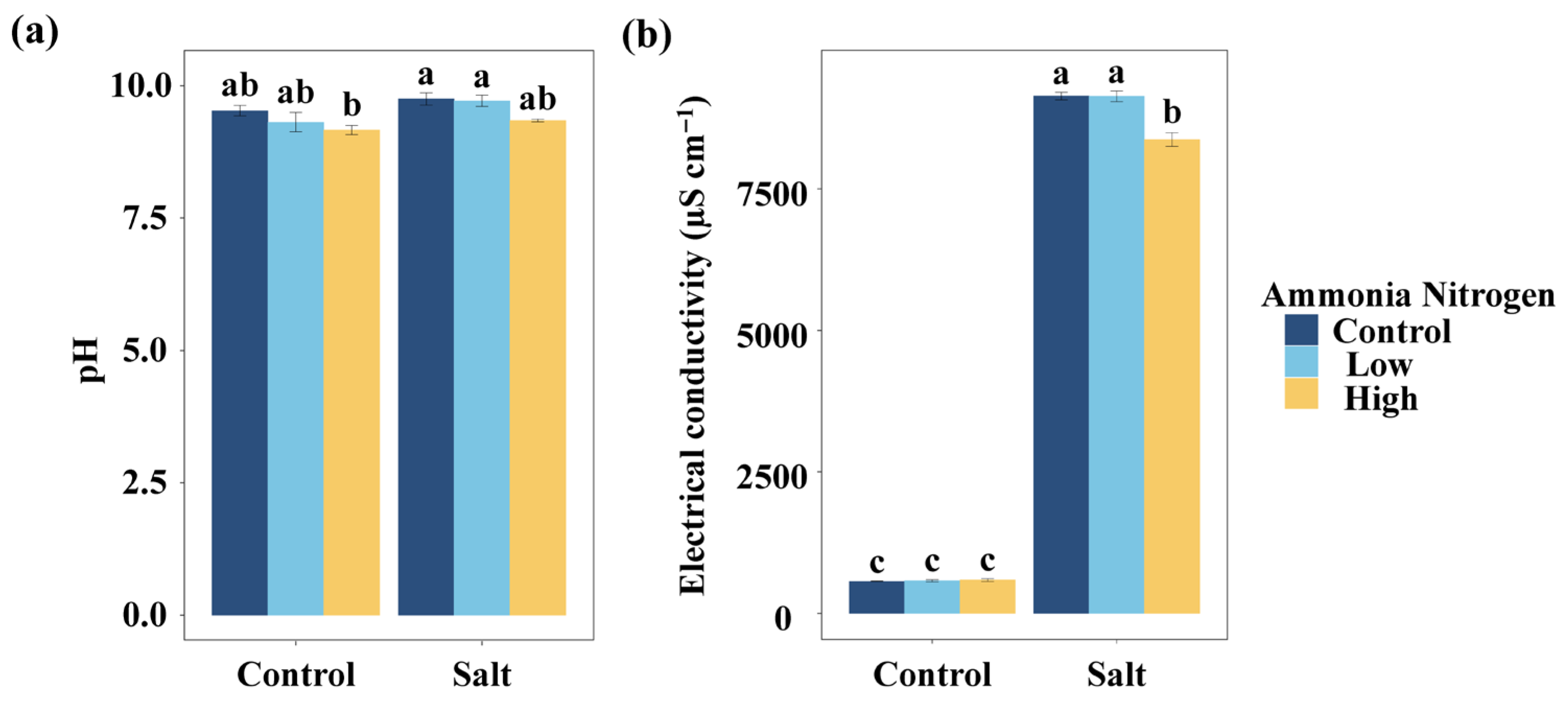
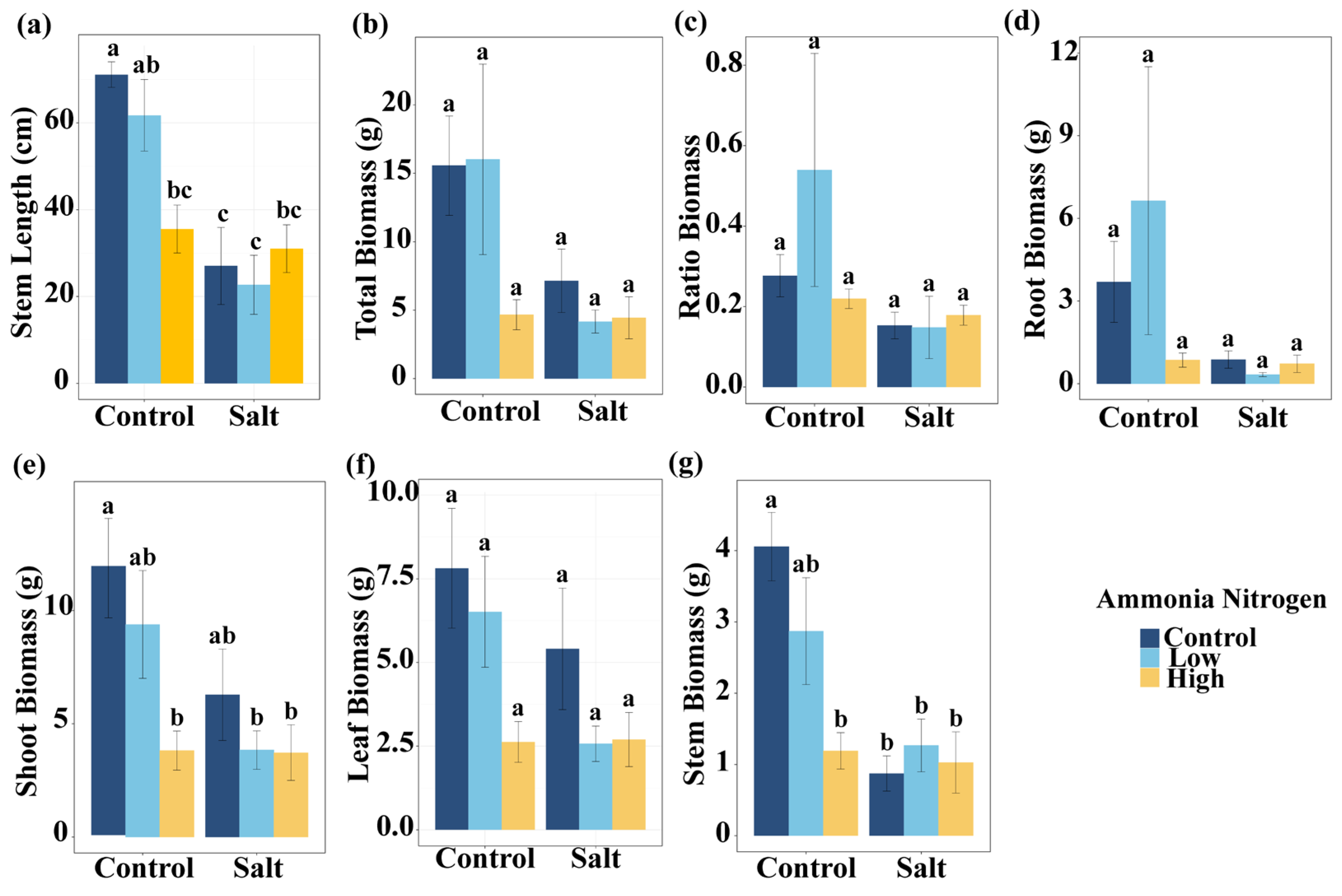
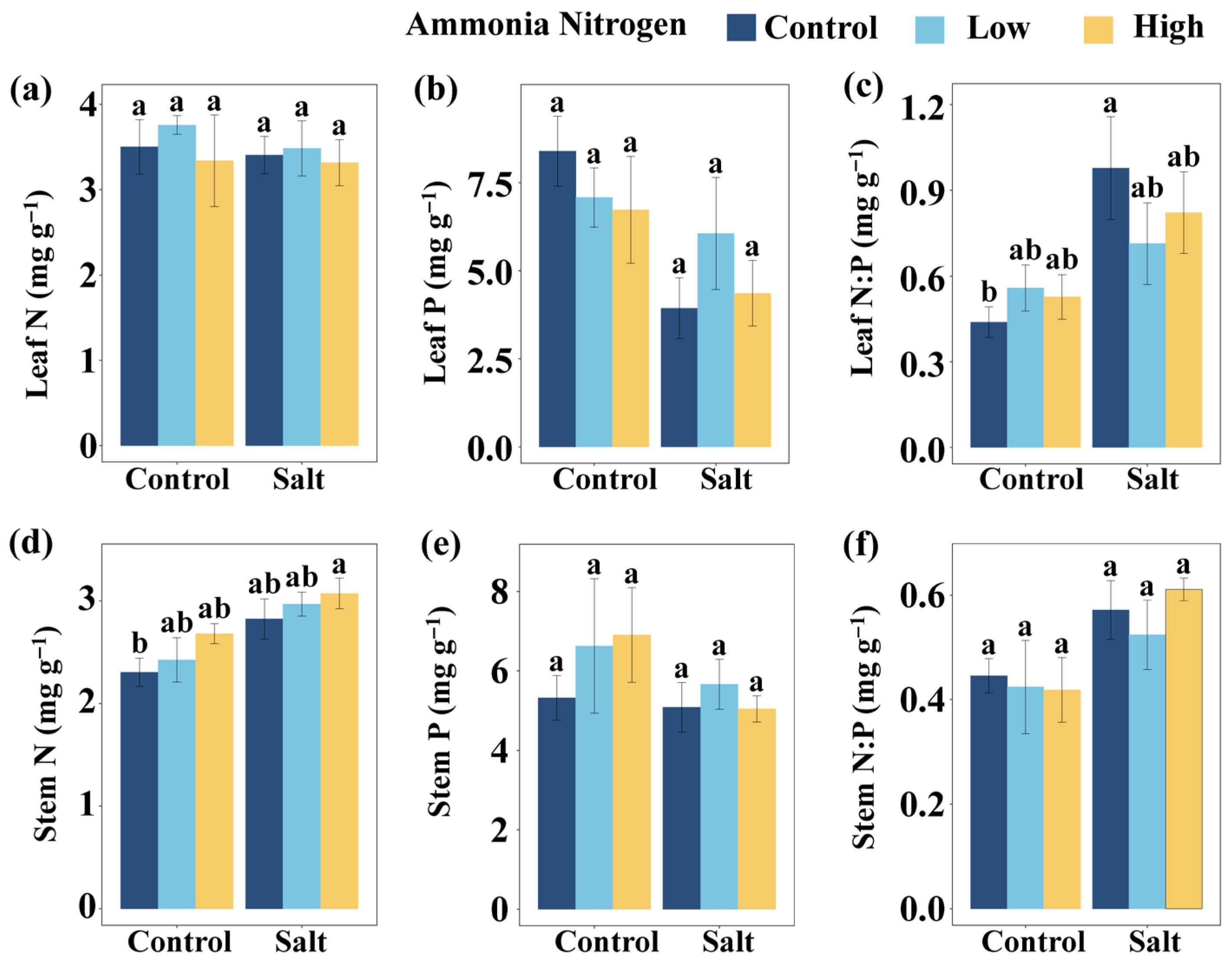
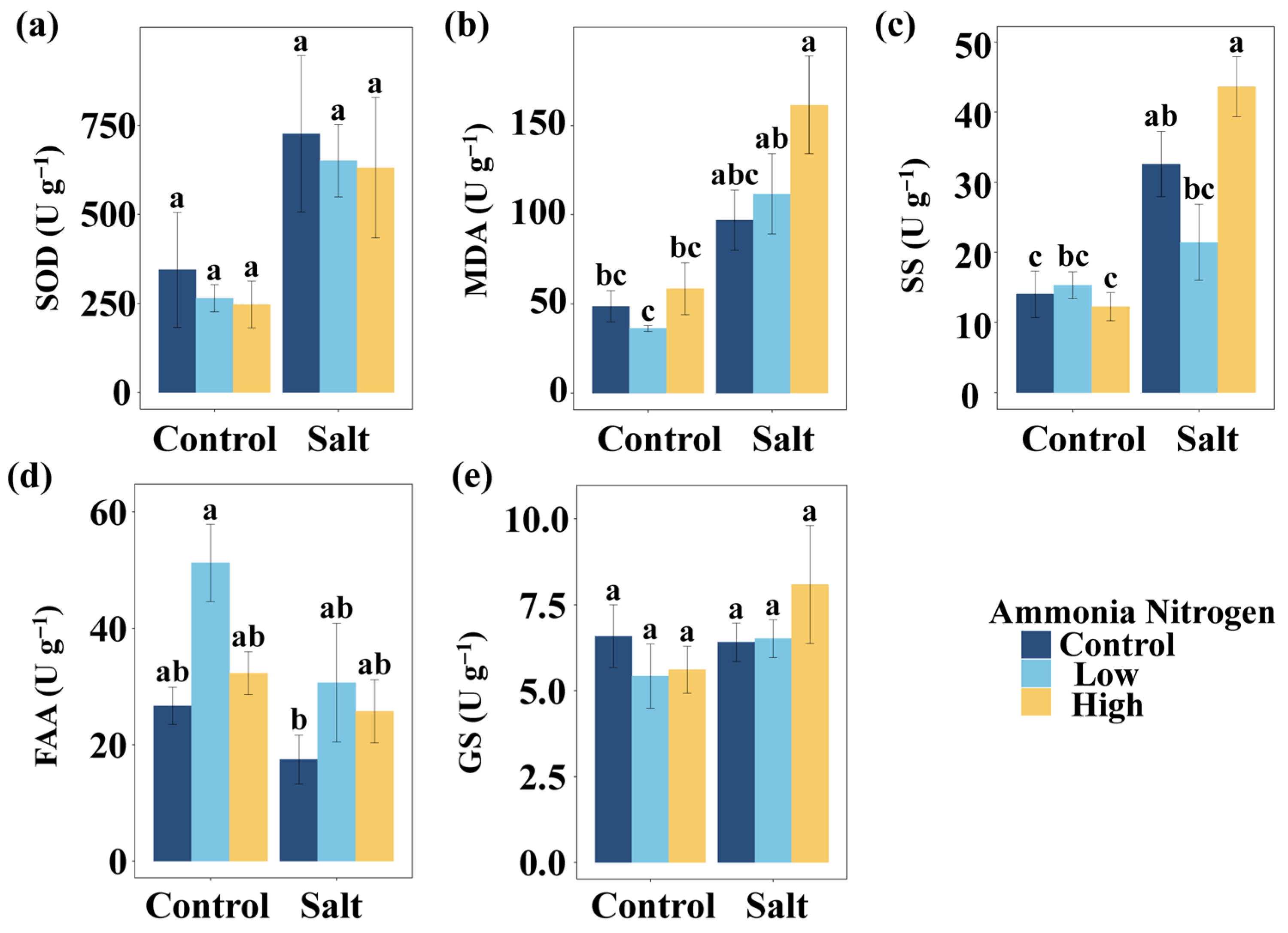
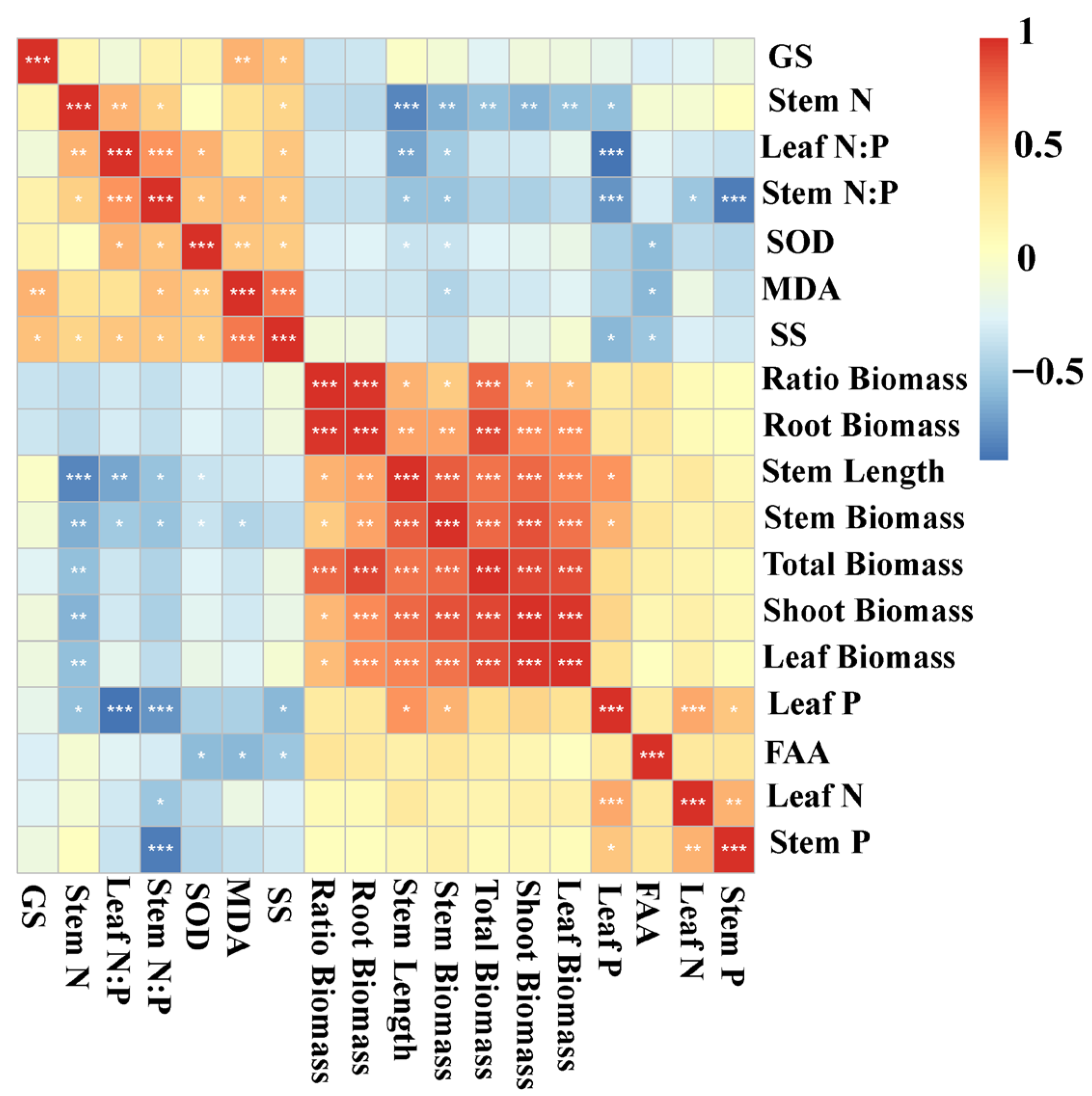
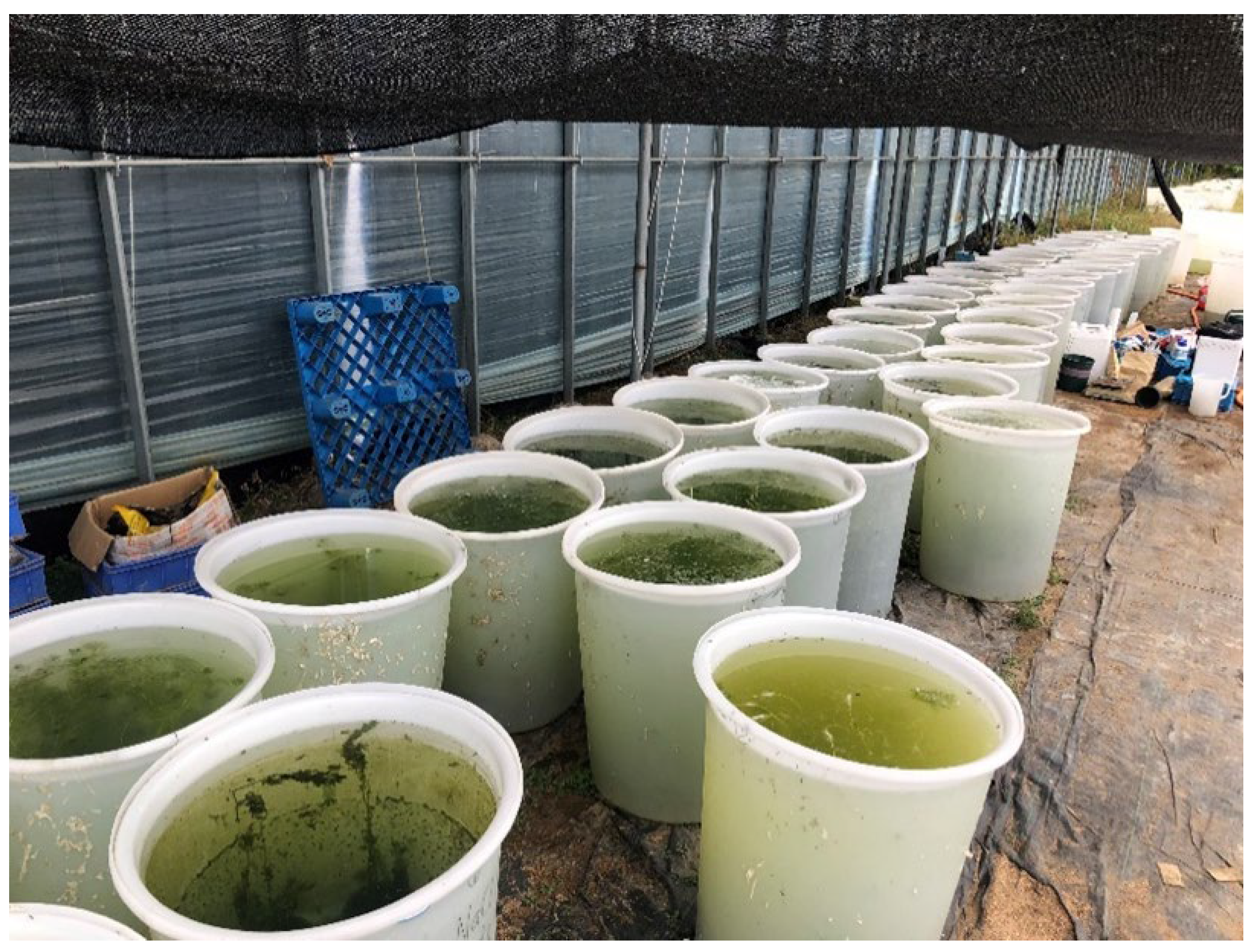
| F (S) | F (N) | F (S × N) | |
|---|---|---|---|
| Stem Length | 28.871 *** | 3.140 | 4.529 * |
| Total Biomass | 6.336 * | 2.293 | 1.348 |
| Root–Shoot Biomass Ratio | 3.282 | 0.802 | 1.085 |
| Root Biomass | 3.504 | 0.8620 | 1.092 |
| Shoot Biomass | 7.733 * | 4.908 * | 1.436 |
| Leaf Biomass | 4.054 | 4.277 * | 0.989 |
| Stem Biomass | 21.348 *** | 5.518 * | 5.077 * |
| F (S) | F (N) | F (S × N) | |
|---|---|---|---|
| Leaf N | 0.178 | 0.373 | 0.074 |
| Leaf P | 6.392 * | 0.399 | 1.047 |
| Leaf N:P | 11.178 ** | 0.197 | 1.410 |
| Stem N | 14.104 ** | 2.017 | 0.121 |
| Stem P | 1.336 | 0.680 | 0.341 |
| Stem N:P | 7.547 * | 0.238 | 0.289 |
| SOD | 10.717 ** | 0.260 | <0.001 |
| MDA | 27.188 *** | 2.449 | 1.255 |
| SS | 26.417 *** | 2.576 | 4.633 * |
| FAA | 5.555 * | 5.534 * | 0.761 |
| GS | 1.753 | 0.421 | 1.078 |
Disclaimer/Publisher’s Note: The statements, opinions and data contained in all publications are solely those of the individual author(s) and contributor(s) and not of MDPI and/or the editor(s). MDPI and/or the editor(s) disclaim responsibility for any injury to people or property resulting from any ideas, methods, instructions or products referred to in the content. |
© 2025 by the authors. Licensee MDPI, Basel, Switzerland. This article is an open access article distributed under the terms and conditions of the Creative Commons Attribution (CC BY) license (https://creativecommons.org/licenses/by/4.0/).
Share and Cite
Yin, M.; Wang, Y.; Song, H.; Dokuchaeva, V.; Wu, P.; Liu, L.; Lin, L.; Guo, W. Effects of Salinity and Eutrophication Variations on the Growth of Myriophyllum spicatum. Plants 2025, 14, 3305. https://doi.org/10.3390/plants14213305
Yin M, Wang Y, Song H, Dokuchaeva V, Wu P, Liu L, Lin L, Guo W. Effects of Salinity and Eutrophication Variations on the Growth of Myriophyllum spicatum. Plants. 2025; 14(21):3305. https://doi.org/10.3390/plants14213305
Chicago/Turabian StyleYin, Meiqi, Yipeng Wang, Huijia Song, Valeriia Dokuchaeva, Pan Wu, Lele Liu, Lele Lin, and Weihua Guo. 2025. "Effects of Salinity and Eutrophication Variations on the Growth of Myriophyllum spicatum" Plants 14, no. 21: 3305. https://doi.org/10.3390/plants14213305
APA StyleYin, M., Wang, Y., Song, H., Dokuchaeva, V., Wu, P., Liu, L., Lin, L., & Guo, W. (2025). Effects of Salinity and Eutrophication Variations on the Growth of Myriophyllum spicatum. Plants, 14(21), 3305. https://doi.org/10.3390/plants14213305






